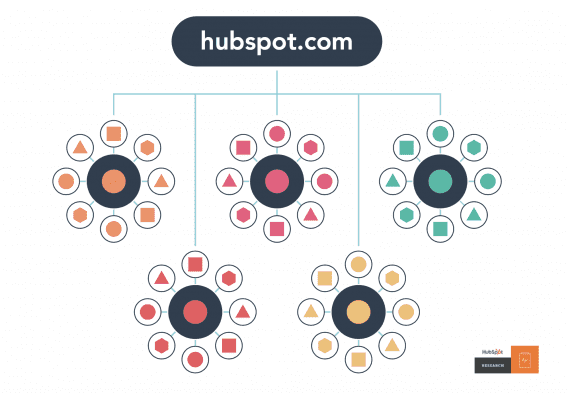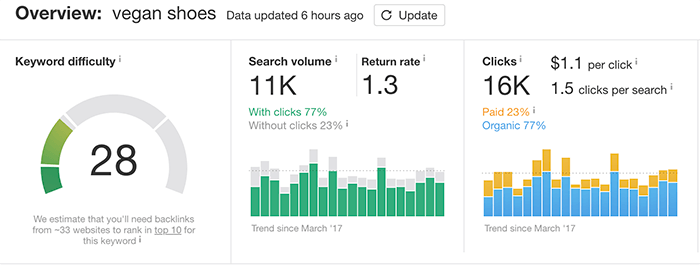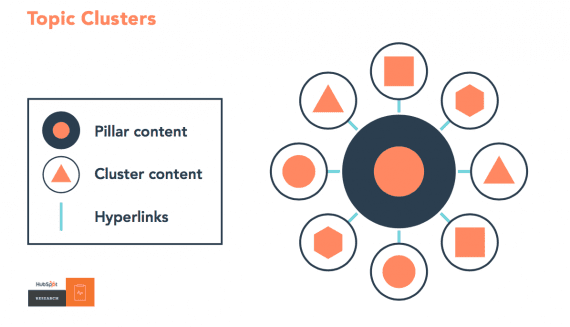Topic clusters are a search engine optimization strategy meant to improve site architecture, help search engines discover important pages, and improve rankings.
While some of the concepts associated with topic clusters are not new to SEO, the strategy’s rising popularity, which HubSpot has fueled, is putting fresh emphasis on internal linking and quality content marketing.
Topic clusters work like this. For each topic cluster “a single ‘pillar’ page acts as the main hub of content for an overarching topic and multiple content pages that are related to that same topic link back to the pillar page and to each other,” wrote Mimi An in a 2017 HubSpot guide.
“This linking action,” An continued, “signals to search engines that the pillar page is an authority on the topic, and over time, the page may rank higher and higher for the topic it covers. The topic cluster model, at its very essence, is a way of organizing a site’s content pages using a cleaner and more deliberate site architecture.”

This example from HubSpot shows a single website domain with several topic clusters. Each cluster is organized around a general and short keyword phrase that the site wants to emphasize and rank for. Subtopic pages link to the pillar page and to each other but rarely link outside of the cluster.
Identify a Topic
To build a topic cluster, first think about your company’s products or services and identify a related, broad theme. For example, a specialty online retailer selling vegan footwear, belts, and bags might choose a topic such as “vegan shoes.”
According to Ahrefs, this broad keyword phrase — vegan shoes — averaged about 11,000 queries a month in 2018 but garnered around 16,000 monthly clicks.

According to Ahrefs, “vegan shoes” averaged about 11,000 queries a month in 2018 but garnered around 16,000 monthly clicks.
Having more clicks (16,000) than queries (11,000) may mean that the folks searching for “vegan shoes” are clicking multiple links. That, in turn, could indicate they are not happy with the results. The phrase also had a relatively low keyword difficulty score of 28. So winning a top spot on Google and other search engine results pages is not out of reach.
Armed with a pillar topic — vegan shoes — create a list of subtopics that support it. Try to answer questions or meet concerns that a person searching for vegan shoes might have. Here are seven examples.
- What are vegan shoes?
- What are vegan shoes made of?
- Why are vegan shoes so ugly?
- How to verify if the shoes are vegan?
- How to clean vegan shoes?
- How durable are vegan shoes?
- Which shoe companies only make vegan shoes?
Pillar Page
A topic cluster begins with a pillar page. To carry our example forward, an online retailer trying to rank well for the pillar topic “vegan shoes” will need to create the best possible guide to understanding, selecting, and buying vegan shoes. This guide (the pillar page) should be a useful resource that honestly helps shoppers understand the category and make good choices. It should be a sterling example of good, quality, helpful content marketing.
The pillar page is valuable to potential customers, and it should include conversion opportunities, too. For example, create a PDF version of the pillar page and let visitors download it when they submit an email address.
Even though you are showing all of the vegan-shoe content right there, not gated, on the pillar page, some readers may still want something to keep and share. If they believe your content is worthwhile, they may be willing to give you an email address for the PDF version.
You might also try other conversions. For example, somewhere on the pillar page include a form for getting a free fit consultation. Visitors could answer a few questions about the sort of shoes they are looking for, provide some foot measurements, and then receive a few recommended shoes to shop for. You may make a sale right then.
Finally, the pillar page should include links to helpful resources that address a particular subtopic in more detail. Often, those links will be to subtopics within your cluster, as well as to external resources.
Subtopic Pages
Next, write or repurpose the cluster’s subtopic pages. The pillar page addresses the topic with broad strokes, covering everything a shopper might need to know about vegan shoes, but at a basic level.
Each subtopic page will focus on a single aspect (associated keyword) and provide a great deal of depth. For example, the subtopic page covering “what vegan shoes are made of” might go into significant detail about cork, cotton, and polyurethane. The pillar page would have mentioned each of these in a section about materials. The subtopic page might describe how the cork is sourced or how polyurethane is added to a cotton backing to make vegan leather.
HubSpot Academy has a good course on topic clusters. Here is one of the videos from that course. It explains pillar pages and subtopics in some detail.
Linking
Each subtopic page in the cluster will link back to the pillar page using the same or similar anchor text. Thus the subtopic page “What are vegan shoes made of” will include a link such as “The ultimate vegan shoe-buying guide.” So will every other subtopic page. In return, the pillar page could link to a subtopic page if it helps readers.

Each subtopic page links to the pillar page.
Again, the strategy of topic clusters has helped to refocus SEO practices on internal linking. Topic clusters do this first by encouraging marketers to create helpful content for human audiences and then associate that content in a way that makes it relatively easy for search engines to identify the semantic relationship between the pillar page and its subtopics.
In this sense, topic clusters are similar to an older strategy called siloing. Bruce Clay, the pioneering SEO practitioner, is credited with creating the silo concept, which organizes site hierarchy around key topics. While there are certainly differences between topic clusters and silos, both create easy-to-follow linking architectures.
Clay described siloing in a 2008 interview with Web Marketing Today.
Consider the illustration below from the Human Proof Designs website. It succinctly explains the benefits of using an internal linking strategy. Looking for an orange jellybean in a sea of different colored jellybeans is difficult. But if all of the jellybeans are sorted into silos by color, finding an orange one is easy.

Looking for an orange jellybean in a sea of other colors is difficult. But if all of the jellybeans are sorted into silos by color, finding an orange one is no problem.
In short, a clear linking strategy may help search engines understand how your topics and subtopics are related.